Analysis and Mitigation of Vibrations in Front Loader Mechanisms Using Hydraulic Suspension Systems
Abstract
1. Introduction
2. Materials and Methods
- X[k] is the complex FFT output at frequency bin k
- |X[k]|: amplitude spectrum
- Fk = (k fs)/N is the corresponding frequency in Hz
- Fs: is the sampling frequency in Hz
- N: is the number of samples in the time-domain signal
3. Results and Discussions
3.1. Peak Acceleration Measurement During Impact
3.2. Time-Domain Vibration Signal Analysis
3.3. Frequency-Domain Analysis (FFT) of Vibration Signal
4. Conclusions
Author Contributions
Funding
Data Availability Statement
Acknowledgments
Conflicts of Interest
Correction Statement
References
- Williamson, C.; Lee, S.; Ivantysynova, M. Active Vibration Damping for an Off-Road Vehicle with Displacement Controlled Actuators. Int. J. Fluid Power 2009, 10, 5–16. Available online: https://journals.riverpublishers.com/index.php/IJFP/article/view/491/259 (accessed on 25 April 2025). [CrossRef]
- Liu, C.; Gu, J.; Du, X.; Yang, L.; Du, Y.; Mao, E. A Vibration Reduction Control Method for Tractor Rear Hydraulic Hitch Based on Pressure Feedback. Agriculture 2023, 13, 1546. [Google Scholar] [CrossRef]
- Yang, Z.; Zhang, W.; Chen, X. Design and Performance of Mechanical Suspension Systems in Agricultural Tractors. J. Agric. Eng. 2021, 37, 45–53. [Google Scholar]
- Kumar, R.; Singh, P. Evaluation of Rubber Mount Systems for Vibration Reduction in Farm Machinery. Biosyst. Eng. 2020, 192, 56–67. [Google Scholar] [CrossRef]
- Li, H.; Wang, J.; Zhao, Y. Hydraulic Damping Technologies for Front Loader Vibration Control: A Review. Mech. Syst. Signal Process. 2022, 170, 108756. [Google Scholar] [CrossRef]
- Zhou, T.; Liu, Q.; Huang, X. Application of Hydraulic Suspensions in Agricultural Vehicles: Advantages and Challenges. Comput. Electron. Agric. 2023, 198, 107123. [Google Scholar] [CrossRef]
- Yu, M.; Evangelou, S.A.; Dini, D. Advances in Active Suspension Control for Off-Road Vehicles. Engineering 2024, 33, 160–177. [Google Scholar] [CrossRef]
- Chen, Y.; Li, X.; Zhao, Z. Semi-Active Suspension Systems: A Review of Control Strategies and Applications in Agricultural Machinery. Sensors 2020, 20, 3442. [Google Scholar] [CrossRef]
- European Machinery Directive 2006/42/EC. Whole-Body Vibration Exposure and Operator Comfort in Agricultural Machinery. Health and Safety Executive 2019. Available online: https://eur-lex.europa.eu/legal-content/EN/TXT/?uri=CELEX%3A02019R1243-20230112 (accessed on 25 April 2025).
- Johnson, M.; Patel, S. Emerging Trends in Suspension Systems for Agricultural Tractors. Biosyst. Eng. 2024, 215, 25–38. [Google Scholar] [CrossRef]
- Sláma, D.; Staněk, L.; Mergl, V. Magnitude of WBV Affecting the Tractor with a Timber Trailer Operator During Individual Timber Forwarding Operations. South-East. Eur. For. 2022, 16, 25–33. [Google Scholar] [CrossRef]
- Brunetti, J.; D’Ambrogio, W.; Fregolent, A. Analysis of the Vibrations of Operators’ Seats in Agricultural Machinery Using Dynamic Substructuring. Appl. Sci. 2021, 11, 4749. [Google Scholar] [CrossRef]
- Barač, Ž.; Plaščak, I.; Jurić, T.; Marković, M. The Impact of Vibrations on the Hand–Arm System and Body of Agricultural Tractor Operators in Relation to Operational Parameters, Approach: Analytical Hierarchical Process (AHP). AgriEngineering 2025, 7, 56. [Google Scholar] [CrossRef]
- Kim, J.-H.; Gim, D.-H.; Nam, J.-S. Experimental Structural Safety Analysis of Front-End Loader of Agricultural Tractor. Agriculture 2024, 14, 947. [Google Scholar] [CrossRef]
- Riccardo, M.; Andrea, V. An Active Oscillation Reduction Method for Off-Highway Front Loaders. Proceedings of the Institution of Mechanical Engineers, Part D. J. Automob. Eng. 2023, 237, 1015–1031. [Google Scholar] [CrossRef]
- Mallette, G.; Gauthier, C.-É.; Hemmatian, M.; Denis, J.; Plante, J.-S. Design and Experimental Assessment of a Vibration Control System Driven by Low Inertia Hydrostatic Magnetorheological Actuators for Heavy Equipment. Actuators 2023, 12, 407. [Google Scholar] [CrossRef]
- Han, G.; Kim, K.-D.; Ahn, D.-V.; Park, Y.-J. Comparative Analysis of Tractor Ride Vibration According to Suspension System Configuration. J. Biosyst. Eng. 2023, 48, 69–78. [Google Scholar] [CrossRef]
- Masa’id, A.; Lenggana, B.W.; Ubaidillah, U.; Susilo, D.D.; Choi, S.-B. A Review on Vibration Control Strategies Using Magnetorheological Materials Actuators: Application Perspective. Actuators 2023, 12, 113. [Google Scholar] [CrossRef]
- ISO 20816-1:2016; Mechanical Vibration—Measurement and Evaluation of Machine Vibration—Part 1: General Guidelines. ISO: Geneva, Switzerland, 2016.
- Brüel & Kjær. Type 4526 High-Temperature CCLD Accelerometer Specifications. Brüel & Kjær Sound & Vibration Measurement A/S. Available online: https://www.bksv.com/en/transducers/vibration/accelerometers/ccld-iepe/4526 (accessed on 30 May 2025).
- Li, X.; Ma, Y.; Zhang, J.; Wang, H. Influence of Sensor Placement on Vibration Measurement Accuracy in Agricultural Machinery. Sensors 2021, 21, 4567. [Google Scholar] [CrossRef]
- Inman, D.J. Engineering Vibration, 4th ed.; Pearson Education: Upper Saddle River, NJ, USA, 2014; Volume 36–41, pp. 58–65. [Google Scholar]
- Almady, S.S.; Al-Janobi, A.A.; Marey, S.A.; Al-Sager, S.M.; Aboukarima, A.M.; Gaddal, Y.H. Establishment of a Measuring Unit Based on Arduino Board for Recording Vibrations on an Agricultural Tractor during Tillage Process. Meas. Control. 2024. [Google Scholar] [CrossRef]
- Xu, G.; Zhu, S.-H.; Nie, X.-T.; He, L. Natural Frequencies Calculation for Vibrating Systems of Tractors Made in China. J. Vib. Shock. 2014, 33, 157–161. [Google Scholar]
- Sun, X.; Liu, Y.; Zhang, L.; Bai, W.; Zhang, Q.; Zhang, Y. Optimal Design of a Tractor Seat Suspension System Based on Multi-Objective Optimization. J. Low Freq. Noise Vib. Act. Control. 2024, 43, 403–420. [Google Scholar] [CrossRef]
- Zindulka, M.; Strecker, Z.; Jeniš, F. Semiactive Seat Suspension for Agricultural Machines. In Proceedings of the 26th International Conference Engineering Mechanics 2020, Brno, Czech Republic, 24–25 November 2020; Brno University of Technology, Institute of Solid Mechanics, Mechatronics and Biomechanics: Brno, Czech Republic, 2020; pp. 548–551. [Google Scholar] [CrossRef]
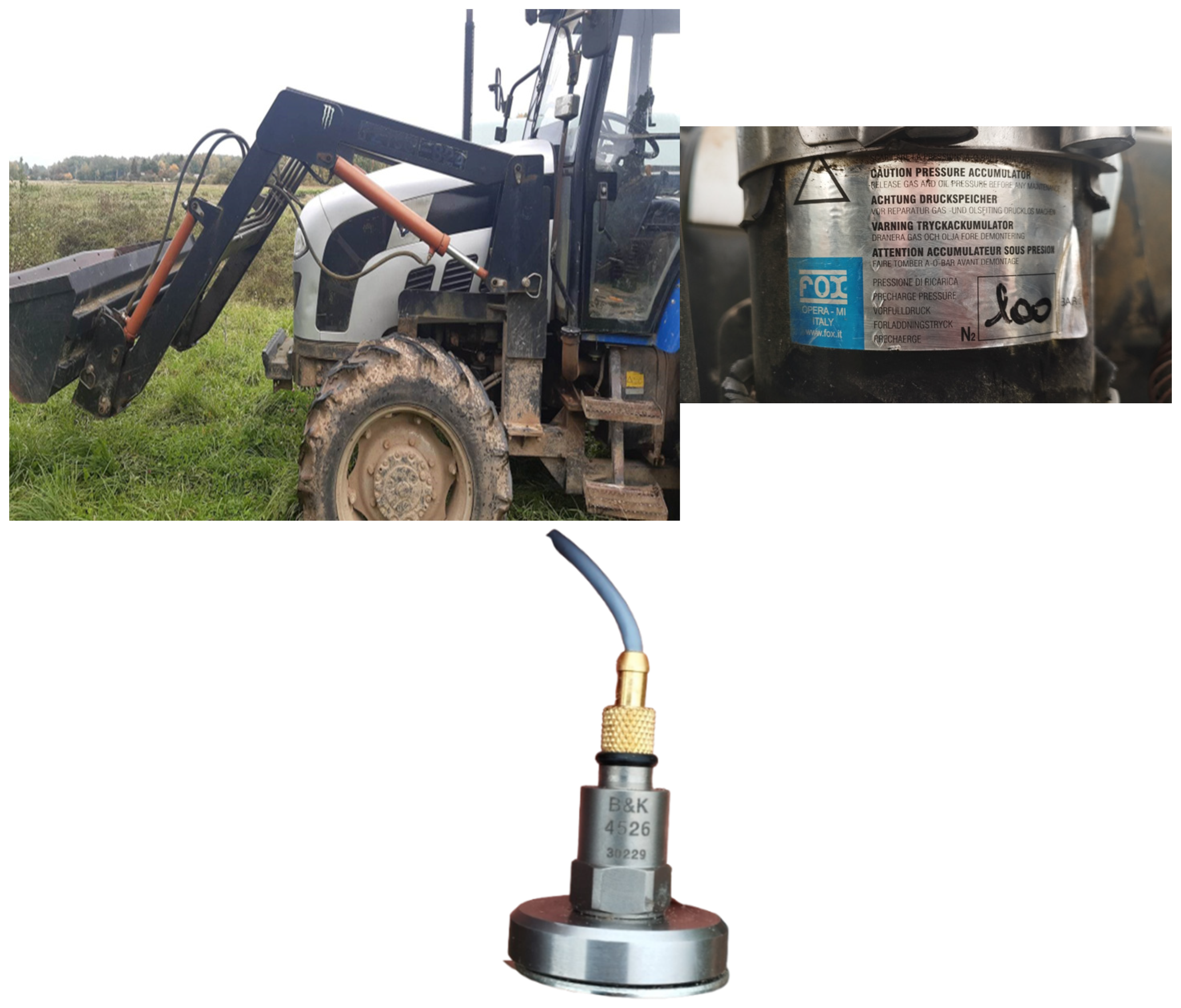


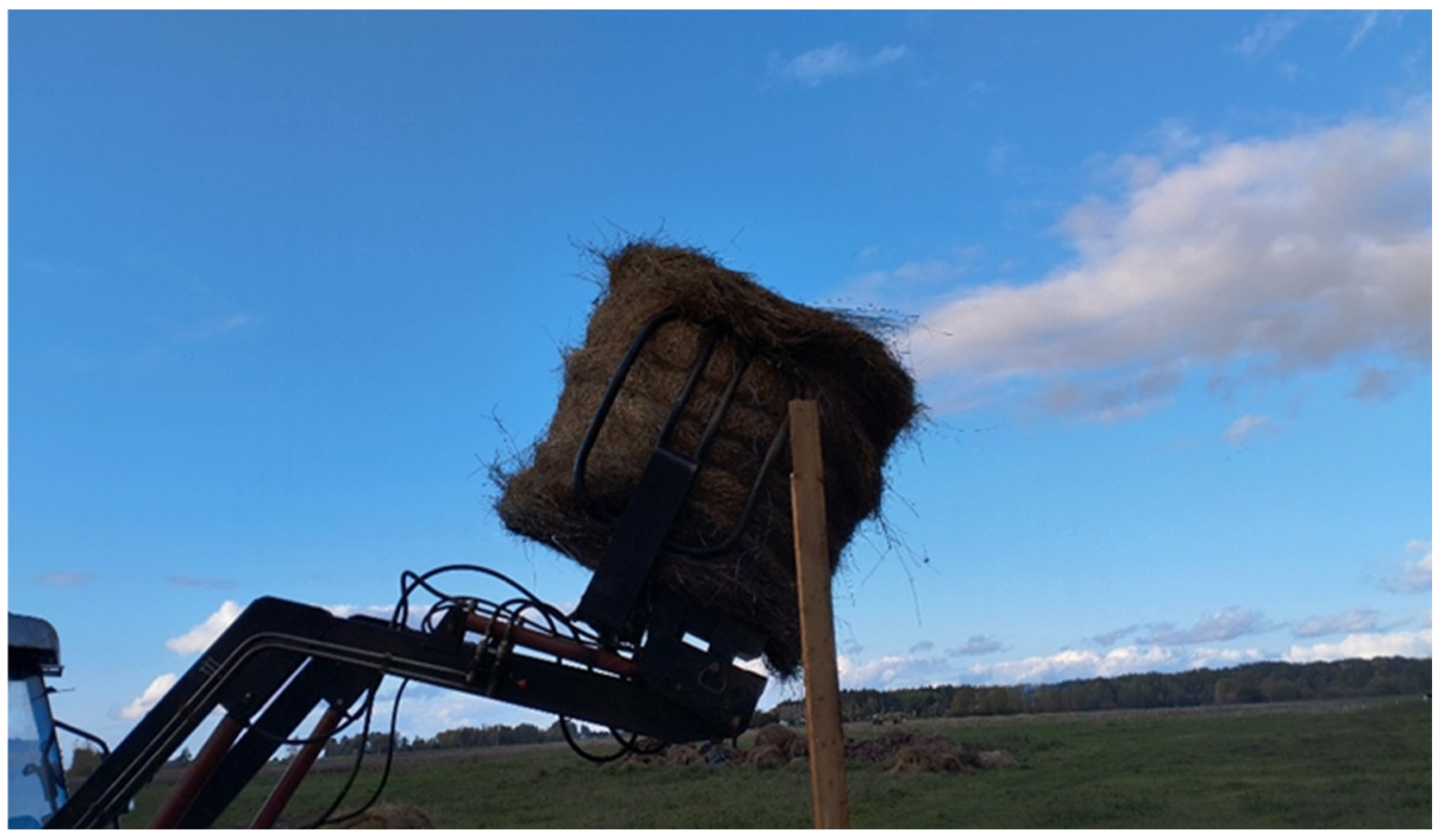
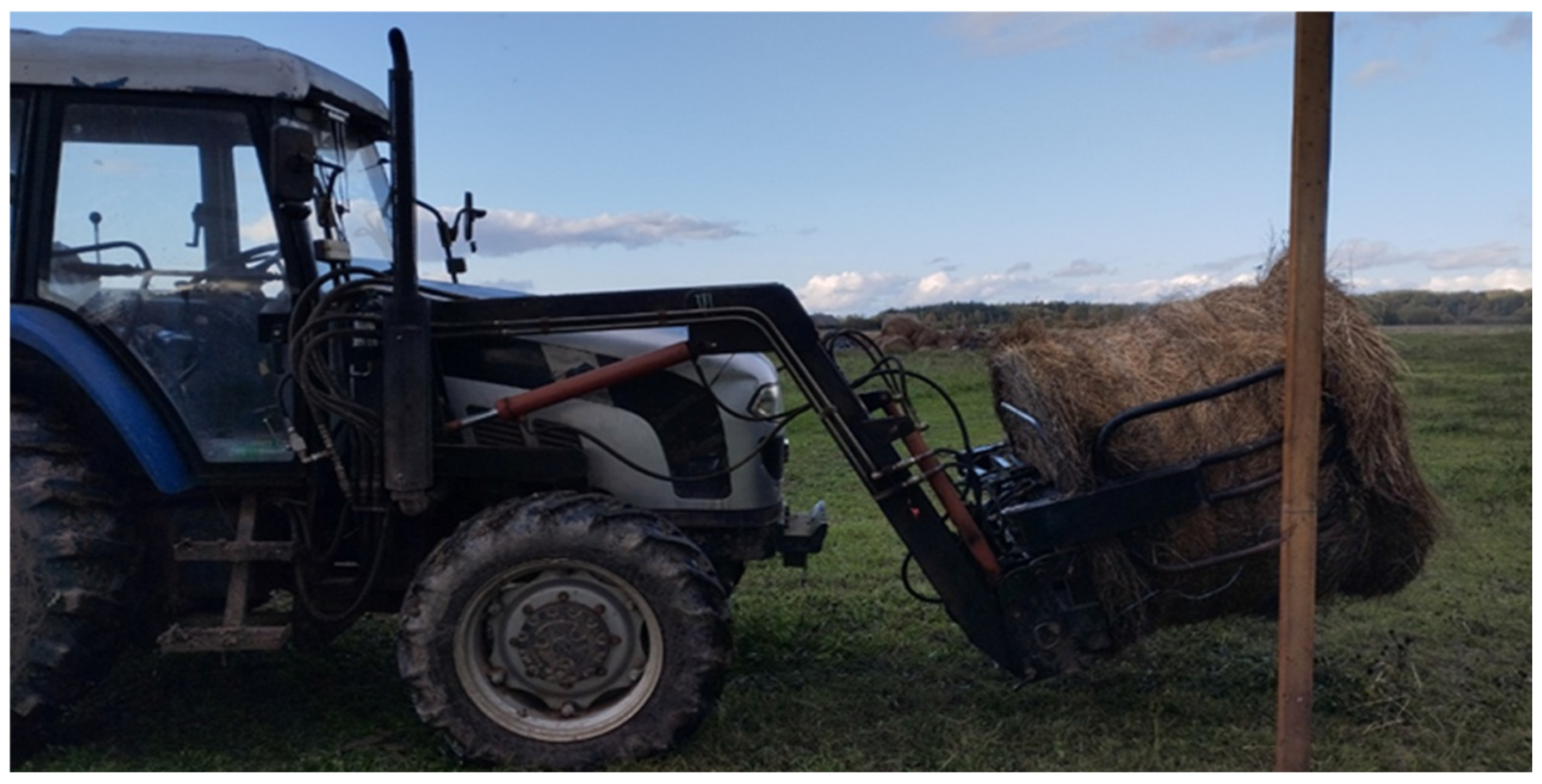
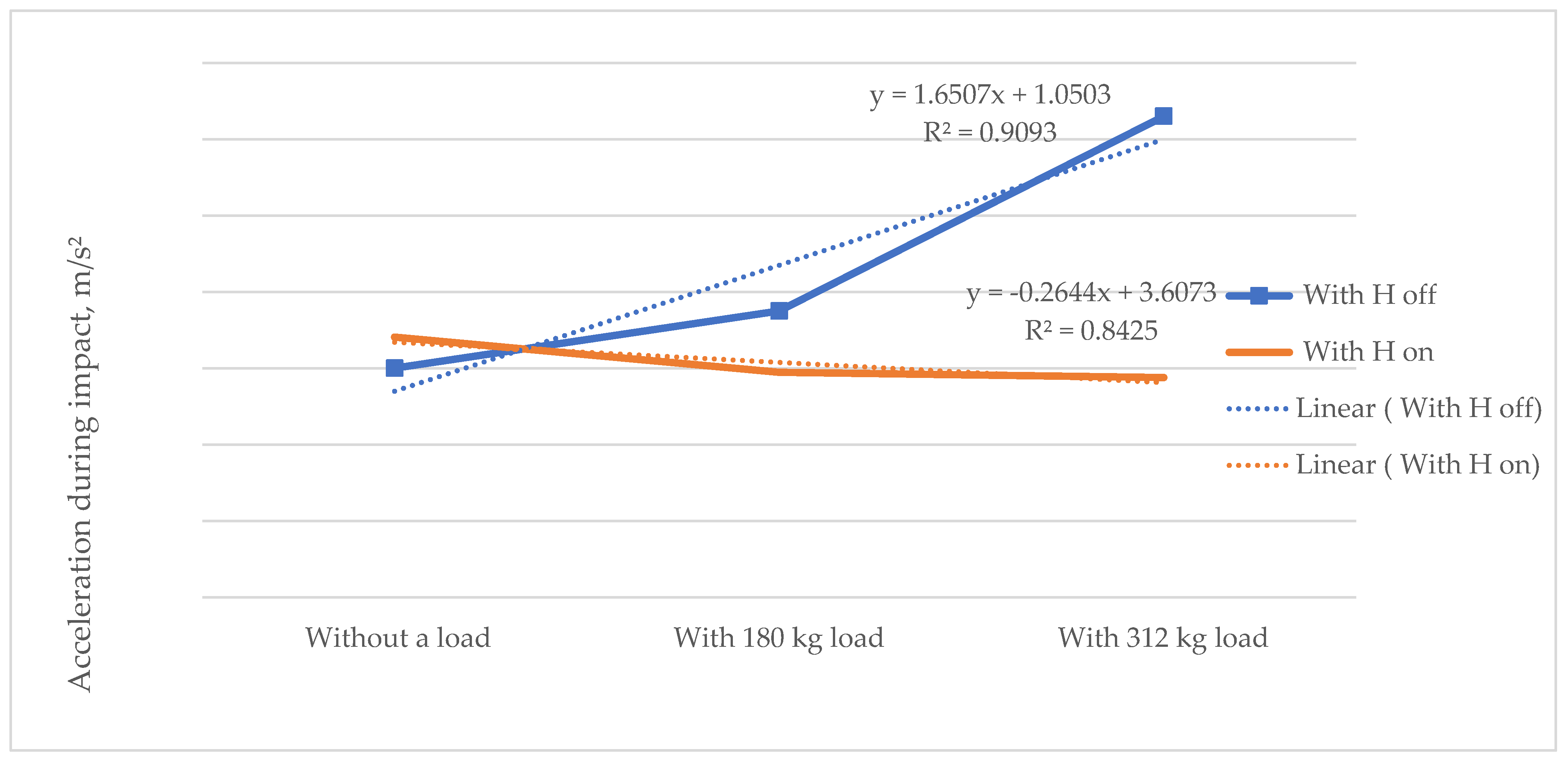
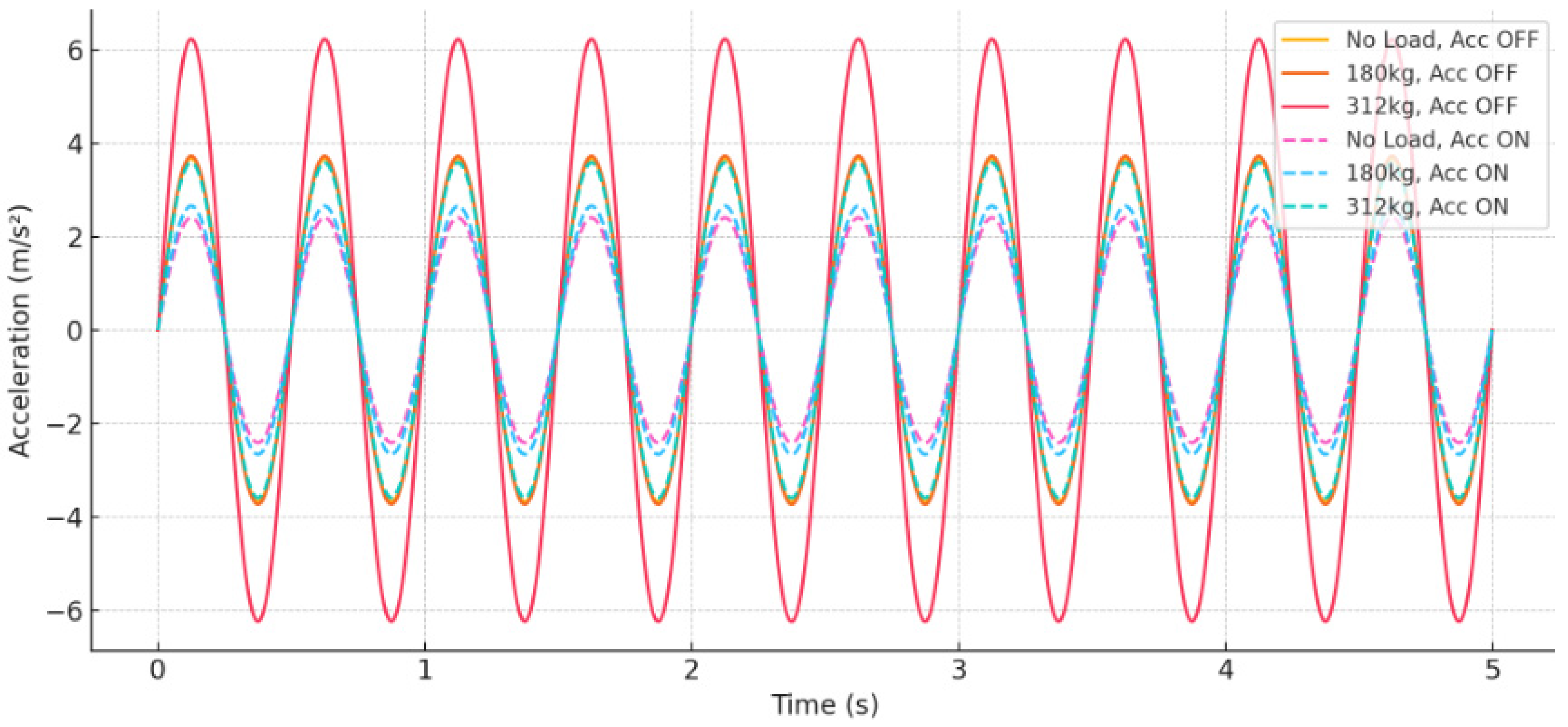
| Parameter | Value |
|---|---|
| Frequency Range | 0.3–8000 Hz |
| Temperature | −54–180 °C |
| Weight | 5 g |
| Sensitivity | 10 mV:ms−2 |
| Connector | 10–32 UNF |
| Signal Output | CCLD |
| Condition | Acceleration of Impact, m/s2 | Average | Standard Deviation | A. Standard Deviation | Student Coefficient (t) | Error | ||
|---|---|---|---|---|---|---|---|---|
| 1st Take | 2nd Take | 3rd Take | ||||||
| Without load, H off | 2.418 | 3.350 | 3.238 | 3.00 | 0.509 | 0.294 | 4.303 | 1.264 |
| Without load, H on | 3.680 | 3.083 | 3.464 | 3.41 | 0.303 | 0.175 | 4.303 | 0.752 |
| With 180 kg load, H off | 3.723 | 3.685 | 3.843 | 3.75 | 0.082 | 0.047 | 4.303 | 0.205 |
| With 180 kg load, H on | 3.539 | 2.939 | 2.362 | 2.95 | 0.588 | 0.340 | 4.303 | 1.464 |
| With 312 kg load, H off | 6.241 | 5.404 | 7.265 | 6.30 | 0.932 | 0.538 | 4.303 | 2.315 |
| With 312 kg load, H on | 2.661 | 3.078 | 2.901 | 2.88 | 0.209 | 0.121 | 4.303 | 0.520 |
| Test Condition | FFT Amplitude at 3–4 Hz (m/s2) | Hydraulic (H) State |
|---|---|---|
| Without load | 2.5 | off |
| Without load | 1.8 | on |
| With 180 kg load | 3.2 | off |
| With 180 kg load | 2.1 | on |
| With 312 kg load | 5.6 | off |
| With 312 kg load | 2.4 | On |
Disclaimer/Publisher’s Note: The statements, opinions and data contained in all publications are solely those of the individual author(s) and contributor(s) and not of MDPI and/or the editor(s). MDPI and/or the editor(s) disclaim responsibility for any injury to people or property resulting from any ideas, methods, instructions or products referred to in the content. |
© 2025 by the authors. Licensee MDPI, Basel, Switzerland. This article is an open access article distributed under the terms and conditions of the Creative Commons Attribution (CC BY) license (https://creativecommons.org/licenses/by/4.0/).
Share and Cite
Bhandari, S.; Jotautienė, E.; Braska, J. Analysis and Mitigation of Vibrations in Front Loader Mechanisms Using Hydraulic Suspension Systems. AgriEngineering 2025, 7, 276. https://doi.org/10.3390/agriengineering7090276
Bhandari S, Jotautienė E, Braska J. Analysis and Mitigation of Vibrations in Front Loader Mechanisms Using Hydraulic Suspension Systems. AgriEngineering. 2025; 7(9):276. https://doi.org/10.3390/agriengineering7090276
Chicago/Turabian StyleBhandari, Shankar, Eglė Jotautienė, and Jonas Braska. 2025. "Analysis and Mitigation of Vibrations in Front Loader Mechanisms Using Hydraulic Suspension Systems" AgriEngineering 7, no. 9: 276. https://doi.org/10.3390/agriengineering7090276
APA StyleBhandari, S., Jotautienė, E., & Braska, J. (2025). Analysis and Mitigation of Vibrations in Front Loader Mechanisms Using Hydraulic Suspension Systems. AgriEngineering, 7(9), 276. https://doi.org/10.3390/agriengineering7090276










